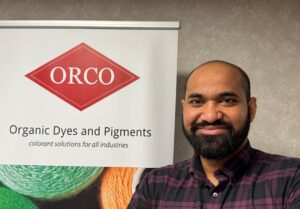How to Pad OrcoSperse™ Pigment Dispersions on Spandex®
A typical pigment padding procedure on Spandex® calls for the following ingredients:
X oz/gal(x g/L) OrcoSperse™ Pigments
1.5-3.0 oz/gal(11.3-23g/L) Orco Antimigrant U-1300™
0.20-.50 oz/gal(1.5-3.75g/L) Orcowet PA™
1.5-2.0 oz/gal(11.3-15.0g/L) Orco Catalyst 781™
10-16 oz/gal(75-120g/L) Orco Pad Binder HLF-P™
0.10-.20 oz/gal(.75-1.5 g/L) Orco Pad Resin FGT™
- The specific data sheet should be consulted for details concerning order of addition but in general, the catalyst and the pigments should be added last and only after the pad bath is almost at its total volume.
- Since pigments are not a solution but rather a fine dispersion, agitation should be used at all times to prevent settling of colors in the bath, and the use of a recirculation pump between the pad trough and the supply tank is highly recommended.
- Dependent upon the type of goods, wet pick-up should be controlled to approximately 50-75% either through pressure adjustment and/or durometer of the rolls.
- A pre-drier such as an infrared unit is recommended to eliminate excessive moisture so that subsequent heating operations can focus on curing the resinous binder and not just creating steam.
- The use of additives such as polyethylene and/or cationic amide type softeners should be used with caution as they can sometimes cause wash and crock problems.
- Melamine formaldehyde crosslinkers such as Orco Pad Resin FGT™ in small amounts are very effective in improving washfastness but should be used with discretion in that they do add measurable amounts of formaldehyde to the system which in certain studies have been found to cause many dermal type problems.
- In the case of the aforementioned system, a cure temperature of at least 275-285°F(135-140°C) for a duration of 50-75 seconds is recommended.
- After-washing is not generally done or necessary.
- In some cases the use of a top crock finish is utilized to form a continuous film over the pigmented coating to improve crock and wash fastness. These topical finishes may be nothing more than a dilution of the binder used in the system or a silicone elastomer such as Orcosil PS-400™.



